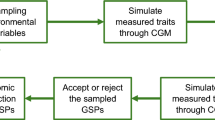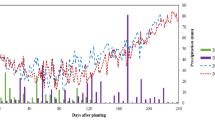Abstract
When utilizing optical sensors to make in-season agronomic recommendations in winter wheat, one parameter often required is the in-season grain yield potential at the time of sensing. Current estimates use an estimate of biomass, such as normalized difference vegetation index (NDVI), and growing degree days (GDDs) from planting to NDVI data collection. The objective of this study was to incorporate soil moisture data to improve the ability to predict final grain yield in-season. Crop NDVI, GDDs that were adjusted based upon if there was adequate water for crop growth, and the amount of soil profile (0–0.80 m) water were incorporated into a multiple linear regression model to predict final grain yield. Twenty-two site-years of N fertility trials with in-season grain yield predictions for growth stages ranging from Feekes 3 to 10 were utilized to calibrate the model. Three models were developed: one for all soil types, one for loamy soil textured sites, and one for coarse soil textured sites. The models were validated with 11 independent site-years of NDVI and weather data. The results indicated there was no added benefit to having separate models based upon soil types. Typically, the models that included soil moisture, more accurately predicted final grain yield. Across all site years and growth stages, yield prediction estimates that included soil moisture had an R2 = 0.49, while the current model without a soil moisture adjustment had an R2 = 0.40.




Similar content being viewed by others
Abbreviations
- DPG:
-
Days of potential growth
- ET:
-
Evapotranspiration
- FWI:
-
Fractional water index
- GDD:
-
Growing degree day
- INSEY:
-
In-season estimate of yield
- NDVI:
-
Normalized difference vegetation index
- PAW:
-
Plant available water
- PET:
-
Potential evapotranspiration
- RMSE:
-
Root mean square error
- SI:
-
Stress index
References
Basara, J. B., & Crawford, T. M. (2000). Improved installation procedures for deep layer soil moisture measurements. Journal of Atmospheric and Oceanic Technology, 17(6), 879–884.
Black, A.L., & Bauer, A. (1988). Setting winter wheat yield goals. In J.L. Havlin (Ed.), Proceeedings of the workshop central great plains profitable wheat management, wichita, KS. 17–20 1988 (pp. 24–34). Atlanta, GA: Potash and Phosphate Institute.
Dahnke, W.C., Swenson, L.J., Goos, R.J., & Laholm, A.G. (1988). Choosing a crop yield goal. SF-822. Fargo: North Dakota State Extension Service.
Demotes-Mainard, S., Jeuffroy, M.-H., & Robin, S. (1999). Spike dry matter and nitrogen accumulation before anthesis in wheat as affected by nitrogen fertilizer: Relationship to kernels per spike. Field Crops Research, 64(3), 249–259.
Evans, L. T., & Fischer, R. A. (1999). Yield potential: Its definition, measurement, and significance. Crop Science, 39(6), 1544–1551.
Fanning, B. (2012). Setting yield goals. South Dakota State University Extension. http://igrow.org/agronomy/wheat/settings-yield-goals/. Accessed 1 Oct. 2015.
Ferris, R., Ellis, R. H., Wheeler, T. R., & Hadley, P. (1998). Effect of high temperature stress at anthesis on grain yield and biomass of field-grown crops of wheat. Annals of Botany, 82(5), 631–639.
Geisseler, D, & Horwath, W.R. (2013). Determining yield goals. California Department of Food and Agriculture. http://apps.cdfa.ca.gov/frep/docs/Yield_Goals.pdf. Accessed 1 Oct. 2015.
Girma, K., Holtz, S. L., Arnall, D. B., Fultz, L. M., Hanks, T. L., Lawles, K. D., et al. (2007). Weather, fertilizer, previous year yield, and fertilizer levels affect ensuing year fertilizer response of wheat. Agronomy Journal, 99(6), 1607–1614.
Girma, K., Martin, K. L., Anderson, R. H., Arnall, D. B., Brixey, K. D., Casillas, M. A., et al. (2006). Mid-season prediction of wheat-grain yield potential using plant, soil, and sensor measurements. Journal of Plant Nutrition, 29(5), 873–897.
Howell, T. A., Steiner, J. L., Schneider, A. D., Evett, S. R., & Tolk, J. A. (1997). Seasonal and maximum daily evapotranspiration of irrigated winter wheat, sorghum, and corn–Southern High Plains. Transactions of the ASAE, 40(3), 623–634.
Hunt, L. A., & Pararajasingham, S. (1995). CROPISM-Wheat: A model describing the growth and development of wheat. Canadian Journal of Plant Science, 75(4), 619–632.
Illston, B. G., Basura, J. B., Fisher, D. K., Elliot, R., Fiebrich, C. A., Crawford, K. C., et al. (2008). Mesoscale monitoring of soil moisture across a statewide network. Journal of Atmospheric and Oceanic Technology, 25(2), 167–182.
Large, E. C. (1954). Growth stages in cereals: Illustration of the Feekes Scale. Plant Pathology, 3(4), 128–129.
Liu, C., Zhang, X., & Zhang, Q. (2002). Determination of daily evaporation and evapotranspiration of winter wheat and maize by large-scale weighing lysimeter and micro-lysimeter. Agricultural and Forest Meteorology, 111(2), 109–120.
McMaster, G. S., & Wilhelm, W. W. (1997). Growing degree-days: One equation, two interpretations. Agricultural and Forest Meteorology, 87(4), 291–300.
Oklahoma Mesonet. (2015). Daily data retrieval. University of Oklahoma. http://www.mesonet.org/index.php/weather/category/past_data_files. Accessed 1 Oct. 2015.
Nix, H. A., & Fitzpatrick, E. A. (1969). An index of crop water stress related to wheat and grain sorghum yields. Agricultural Meteorology, 6(5), 321–337.
Porter, J. R., & Gawith, M. (1999). Temperatures and the growth and development of wheat: A review. European Journal of Agronomy, 10(1), 23–36.
Porter, J.R., & Moot, D.J. (1998). Research beyond the means: Climatic variability and plant growth. In N.R. Dalezios (Ed.), International symposium on applied agrometeorology and agroclimatalology (pp 13–25). Office for Official Publication of the European Commission, Luxembourg
Raun, W. R., Solie, J. B., Johnson, G. V., Stone, M. L., Lukina, E. V., Thomason, W. E., et al. (2001). In-season prediction of potential grain yield in winter wheat using canopy reflectance. Agronomy Journal, 93(1), 131–138.
Raun, W. R., Solie, J. B., Stone, M. L., Martin, K. L., Freeman, K. W., Mullen, R. W., et al. (2005). Optical sensor-based algorithm for crop nitrogen fertilization. Communications in Soil Science and Plant Analysis, 36(19–20), 2759–2781.
Rehm, G., & Schmitt, M. (1989). Setting realistic crop yield goals. Minnesota Ext. Serv. AG-FS-3873. University of Minnesota.
Robinson, J. B., Freebairn, D. M., Dimes, J. P., Dalal, R. C., Thomas, G. A., & Weston, E. J. (1999). Modeling wheat production from low-rainfall farming systems in northern Australia. Environmental International, 25(6–7), 861–870.
SAS Institute Inc. (2011). SAS/STAT® 9.3 User’s Guide. Cary, NC: SAS Institute Inc.
Sharma, L. K., & Franzen, D. W. (2013). Use of corn height to improve relationship between active optical sensor readings and yield estimates. Precision Agriculture,. doi:10.1007/s11119-013-9330-9.
Singandhupe, R. B., & Sethi, R. R. (2005). Estimation of reference evapotranspiration and crop coefficient in wheat under semi-arid environment in India. Archives of Agronomy and Soil Science, 51(6), 619–631.
Soil Survey Staff. 2012a. Official soil series description. USDA-NRCS. http://soils.usda.gov/technical classification/osd/index.html. Accessed 1 April 2012.
Soil Survey Staff. 2012b. Web soil survey: Soil data mart. USDA-NRCS. http://websoilsurvey.nrcs.usda.gov. Accessed 1 April 2012.
Solie, J. B., Raun, W. R., Whitney, R. W., Stone, M. L., & Ringer, J. D. (1996). Optical sensor based field element size and sensing strategy for nitrogen application. Transactions of the ASAE, 39(6), 1983–1992.
Soltani, A., & Sinclair, T. R. (2012). Modeling Physiology of Crop Development. Cambridge, MA: Growth and Yield. CAB International.
Stephens, D. J., Lyons, T. J., & Lamond, M. H. (1989). A simple model to forecast wheat yield in Western Australia. Journal of the Royal Society of Western Australia, 71(2–3), 77–81.
Stone, P. J., & Nicolas, M. E. (1994). Wheat cultivars vary widely in their responses of grain yield and quality to short periods of post-anthesis heat stress. Australian Journal of Plant Physiology, 21(6), 887–900.
Stone, M. L., Solie, J. B., Raun, W. R., Whitney, R. W., Taylor, S. L., & Ringer, J. D. (1996). Use of spectral radiance for correcting in-season fertilizer nitrogen deficiencies in winter wheat. Transactions of the ASAE, 39(5), 1623–1631.
Thakur, P., Kumar, S., Malik, J. A., Berger, J. D., & Nayyar, H. (2010). Cold stress effects on reproductive development in grain crops: An overview. Environmental and Experimental Botany, 67(3), 429–443.
Walsh, O. S., Klatt, A. R., Solie, J. B., Godsey, C. B., & Raun, W. R. (2013). Use of soil moisture data for refined Greenseeker sensor based nitrogen recommendations in winter wheat (Triticum aestivum L.). Precision Agriculture, 14(3), 343–356.
Wheeler, T. R., Batts, G. R., Ellis, R. H., Hadley, P., & Morison, J. I. L. (1996). Growth and yield of winter wheat (Triticum aestivum) crops in response to CO2 and temperature. Journal of Agricultural Science, Cambridge., 127(1), 37–48.
Acknowledgments
The authors would like to thank the Oklahoma Soil Fertility Research and Education Advisory Board for their funding of this research project and their continued financial support of soil fertility research at Oklahoma State University. The authors would also like to express their sincere gratitude to all the current and former soil fertility graduate students who aided in the data collection and maintenance of trials.
Author information
Authors and Affiliations
Corresponding author
Ethics declarations
Conflict of Interest
The mention of any trademarked products or equipment utilized in this experiment was for research purposes only and does not act as an endorsement by Oklahoma State University. The authors and Oklahoma State University have no direct financial relation with any of the named manufacturers, thus the authors declare there is no conflict of interest regarding the publication of this manuscript.
Rights and permissions
About this article
Cite this article
Bushong, J.T., Mullock, J.L., Miller, E.C. et al. Development of an in-season estimate of yield potential utilizing optical crop sensors and soil moisture data for winter wheat. Precision Agric 17, 451–469 (2016). https://doi.org/10.1007/s11119-016-9430-4
Published:
Issue Date:
DOI: https://doi.org/10.1007/s11119-016-9430-4




